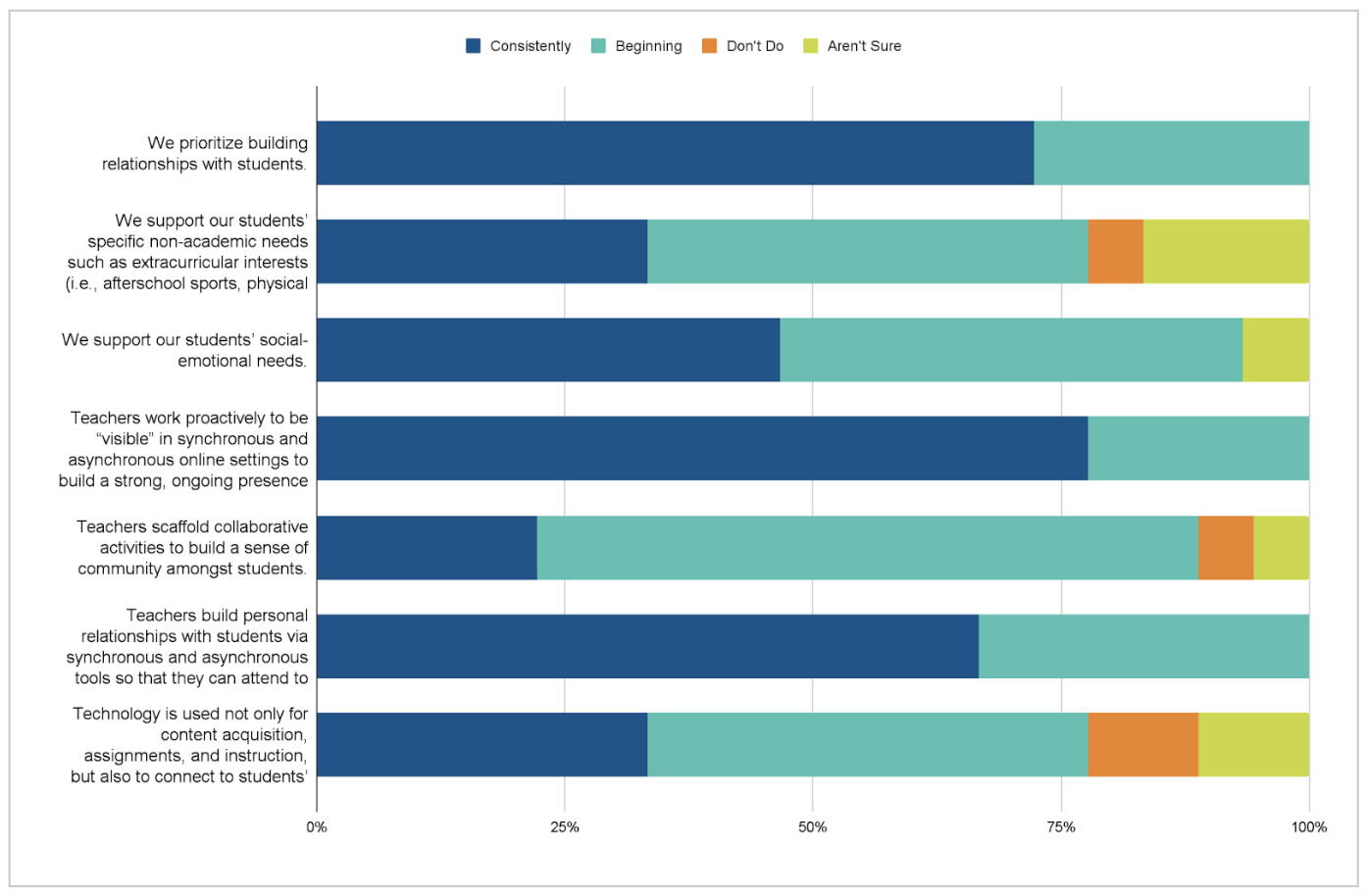This case study describes how three school systems conducted pilot programs and analyzed data during their participation in The Learning Accelerator (TLA)’s Strategy Lab program. Teams leveraged TLA’s Real-Time Redesign process to identify and implement solutions for challenges to equity in their virtual and hybrid learning schools.
Key Points and Takeaways
Sense of belonging is critical to students’ holistic development, engagement in learning, and academic achievement. This is true regardless of learning modality or location. However, the challenge of building belonging can be heightened in virtual learning experiences.
For students to thrive in a virtual/hybrid learning environment, schools need to integrate purposeful and consistent behaviors and support structures that foster a sense of belonging for all students.
To do this, educators can proactively address the belonging challenges through actions like carefully constructing norms and facilitating interpersonal connections and communities, attending to student emotions and holistic needs; and deliberately fostering relationship-building (i.e., student-to-student and student-to-teacher connections).
Both educators and students need explicit, intentional development and supports to understand the importance of belonging and to execute effective, ongoing action together.
What the Research Says About Student Belonging
Research consistently finds that a strong sense of belonging – “a sense that one has a rightful place in a given academic setting and can claim full membership in a classroom community (Farrington et al. 2012)” – is critical to student learning. As a core “building block” for comprehensive student development, belonging is a student mindset that helps learners feel connected to community and contributes to resilience, academic tenacity, and, ultimately, achievement (Stafford-Brizzard 2016). While belonging is something an individual develops, it is fostered directly by environmental factors educators put into place, such as the building of a “safe and caring” community, routines for knowing and supporting students, and culturally responsive and inclusive practices (Learning Policy Institute and Turnaround for Children USA, 2021).
The Challenge of Addressing Student Feelings of Belonging Virtually
Understanding and tackling the challenge of student belonging can be especially difficult for educators, parents, and students in virtual and hybrid classrooms. As TLA learned from the analysis of the research, students often report that learning in a virtual classroom can feel isolating given physical distance from peers and teachers, contributing to feelings of separation and detachment – which can negatively impact engagement and, ultimately, learning. The research also suggests that educators can proactively address this challenge through effective virtual learning design and execution (via setting a foundation for self-directed learning and putting in place key technological, pedagogical, and relational components of instruction).
Put together, it is crucial that virtual and hybrid learning environments not only attend to students’ emotions on the other side of the screen – but also prioritize building relationships and creating a sense of social presence similar to the feelings of community students would experience in an in-person environment. Teachers need to know how to cultivate a sense of belonging and connectedness among students by ensuring:
Teachers have sufficient knowledge of relationship-building strategies so they can implement approaches that are appropriate for their context and students.
Teachers understand and appreciate the importance of providing time for students to build relationships and connections with peers and teachers.
Leaders and teachers establish clear routines and guidelines for developing a positive school and classroom culture – and clearly communicate these with students and families.
Students have opportunities to share the support structures they need to grow personally and academically.
What We Observed in Strategy Lab Systems and Pilots
The TLA Research & Measurement team identified belonging as a distinct need after analyzing data collected throughout the Strategy Lab process. This involved repeated analysis of workbook entries, meeting and coaching notes, and digital artifacts such as data repository spreadsheets, self- and team assessments, and collaborative documents provided by each district to identify emerging topics and themes. The topic of belonging first emerged as a potential challenge in our analysis of the teams’ self-assessment – a research-based measurement tool designed to facilitate meaningful conversations about quality in virtual/hybrid learning environments and help teams identify potential problems of practice in context.
While examining items from the team assessments that alluded to relationships, connection, community, and social-emotional needs, TLA identified trends associated with a sense of belonging. Participant responses on select items revealed that although approximately 70-80% of schools and teachers prioritized building relationships with students and proactively being “visible” in synchronous and asynchronous online settings, the majority of systems indicated they were at the beginning stages of cultivating a sense of belonging for students, particularly as it related to personalized, interest-based, and collaborative learning activities. Another discrepancy appeared in team assessments related to supporting students’ social-emotional needs. As research and field practice has shown, students benefit from socially connected learning opportunities – ones that encourage them to make meaningful, supportive connections with teachers, peers, and the content of their learning in order to persist, deepen commitment, and co-create together.
Team responses using the Stoplight Protocol from Data Wise to identify the degree to which their policies and practices fostered a sense of belonging for students.

A deeper analysis of all 20 district teams’ workbooks, coaching notes, interviews, team reflections, individual and team assessments, and collaborative activities revealed three systems in which belonging emerged as a recurring and predominant theme. Needs assessments revealed similar root causes to their problems of practice: intentionally designing opportunities for relationship-building and instilling a sense of belonging. Although these schools shared a similar challenge, they each chose a different way to address the issue:
KIPP DC designed a professional learning program for teachers and instituted a one-to-one advisory check-in where teachers and students could meet privately.
Cooperative Virtual Learning Academy created a support-system protocol to build a welcoming classroom community for new and current students.
FLEX Online designed a professional development program for teachers and instituted a welcome routine to begin each class.
The summaries below provide an overview of the schools in which belonging emerged as a root cause in their problem of practice, with links to individual case studies focused on each system that offer additional information and context.
KIPP DC
KIPP DC is a virtual charter school with an enrollment of 200 students in grades 2-8, located in an urban, charter district in Washington, D.C.
Belonging: District leaders noticed that their instructional program did not score well in the relationships category of the team assessment. In their “State of the Team” document, they flagged that instilling a sense of belonging was important for students but not yet a consistent practice.
Pilot Plan: Increase teacher awareness of best practices for engaging students and address relationship-building between teachers and students through the introduction of weekly advisory check-ins with students who were struggling academically.
Cooperative Virtual Learning Academy
Cooperative Virtual Learning Academy is a virtual school with an enrollment of 100 K-12 students, located across several districts in the Albany, New York area.
Belonging: Academy leaders shared that although their instructional programming at the elementary level was intended to consistently support relationship- building, students still struggled to make connections with peers and teachers. This was exacerbated given the dynamic nature of school enrollment.
Pilot Plan: Increase awareness and common execution of systems to support building a welcoming environment for new students.
FLEX Online
FLEX Online is a virtual school with an enrollment of 1,430 K-12 students, located in a suburban district in Beaverton, Oregon.
Belonging: District leaders found that despite ongoing efforts by staff and teachers to build relationships with students, the school struggled with developing consistent connections, particularly amongst more disengaged learners.
Pilot Plan: Increase teacher awareness of how to build a supportive classroom environment and address issues of belonging by instituting routines at the beginning of class that focus deliberately on relationship-building.
Each system chose a solution that was specific to their teachers, learning context, and students’ needs. However, common attributes included:
Moving beyond relying on implicit relationship-building and ad hoc support to the creation and implementation of consistent norms and routines.
Supporting teachers to know how to design effective instruction to intentionally support relationship-building among students, peers, and teachers.
Engaging students through modeling, encouragement, and providing ample opportunities to interact with peers, teachers, and staff both academically and socially.
Put together, these pilots increased teacher knowledge around designing and implementing engaging and meaningful learning experiences, as well as fostering community-building in the virtual/hybrid classroom. This resulted in stronger cultures of belonging and community and helped students feel more engaged, motivated to learn, and able to focus on their academic goals.
Taking It Forward
The challenge of ensuring student belonging can be mitigated through the implementation of quality drivers for effective instruction: technology, pedagogy, and relationships. As TLA learned with the three schools highlighted in this case study:
Teachers need to know how to foster a sense of belonging in synchronous and asynchronous learning environments; and
Students need clear guidelines, support, and encouragement for contributing to the development of a positive classroom culture.
Sustaining data-driven, personalized approaches to teaching and learning requires coherent, system-wide shifts in both strategy and practice. As the three schools featured in this case study demonstrated, there is no single, correct pathway to address a common problem of practice. The “right” solutions are contextual and highly dependent upon available resources.
As concrete action steps, TLA encourages leaders exploring this Insight to begin addressing the issue of belonging by:
1. Building an inclusive team: Bring together a diversity of perspectives, ideas, and experiences.
2. Gathering data to understand the challenge: As a team, examine the quality of your virtual/hybrid learning environment.
3. Identifying and implementing the conditions necessary to support planning, adoption, and scaling of new initiatives: To address issues around belonging, districts must ensure that a positive school culture is cultivated, students and teachers have time to build connections, and a sustainable professional learning program for teachers exists. All of these components support effective teaching and learning practices that are targeted and relevant as well as socially connected.
4. Identifying and implementing promising practices: Teachers need to intentionally select strategies that cultivate a sense of belonging in the virtual/hybrid learning environment while also attending to students’ academic and non-academic needs.
5. Measuring progress to inform improvement efforts: Designing measurable solutions lies at the heart of the Strategy Lab process. In addition to following Real-Time Redesign – a framework for quickly making improvements that are scalable, iterative, and relevant to district needs – along with TLA’s Research and Measurement Guide, begin by exploring the strategies below.
